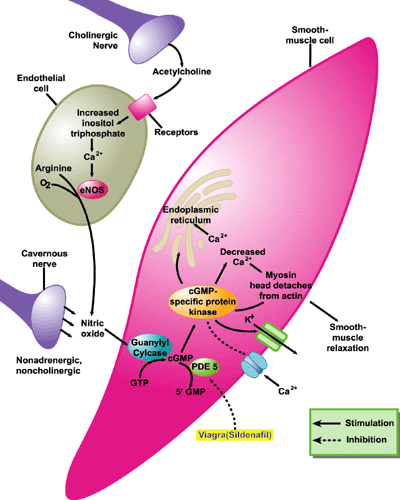 |
|
||||||||||
|
|
|||||||||||
Nitric Oxide and Viagra
ViagraIn a random survey of males aged 40-70, more than 50 percent indicated that they had some form of erectile dysfunction (ED), i.e., the inability to achieve an erection. The development of the drug Viagra, an inhibitor of cyclic GMP-specific phosphodiesterase, has been of great importance to many males suffering from ED. Achievement of a penile erection in males is largely an application of basic principles of hydraulics. Stimulation of the nerves innervating the penis causes the dilation of the deep arteries supplying blood to the penis. The large amount of blood entering the penis engorges the cavernous blood sinuses comprising much of the penis volume. This engorgement in turn acts to compress the veins draining blood from the penis. The increased inflow and decreased outflow of blood causes an erection. Cessation of nervous impulses to the penis acts to abolish the erection. Nitric OxideNitric oxide (NO) is of major importance in the signaling pathways leading to penile erections. NO is very unique for a biochemical signalling molecule because it is a gas. NO displays free radical behavior, and is formed from arginine by the enzyme nitric oxide synthase (NOS): arginine + O2 As a gas, NO is able to pass through cell membranes without the aid of dedicated transporters and its free radical character makes it particularly reactive with iron-containing proteins.
NO acts as a vasodilator in the process of penile erection. NO is supplied from two sources. The first is as a neurotransmitter liberated by the cavernous nerve which innervates smooth muscle surrounding penile arteries. The second source is the endothelial cells lining the deep arteries of the penis. Endothelium-derived NO is formed in response to stimulation of the endothelial cells by cholinergic nerves. Acetylcholine causes the production of inositol triphosphate (IP3), an important second messenger in many hormone signal transduction pathways. IP3 opens calcium channels in the endoplasmic membrane of the endothelial cells; the liberated calcium then activates NO synthase and causes the production of NO. Whatever the source, endothelial cells or cavernous nerve, NO diffuses across the muscle cell membrane and binds to guanylyl cyclase. Guanylyl cyclase catalyzes the synthesis of cyclic GMP from GTP. cGMP then activates a cGMP dependent protein kinase which in turn stimulates the uptake of calcium by the endoplasmic reticulum of the muscle cell. The reduced levels of cytoplasmic calcium cause the muscle cell to relax. As a consequence of muscle cell relaxation, vasodilation occurs.
As is true of any signaling pathway, there must be a way to terminate the action of the signal. cGMP is converted into GMP by a specific phosphodiesterase (PDE.) There are 10 families of PDEs: PDE1-10. The major PDE found in vascular smooth muscle is PDE5. Viagra (sildenafil) is a specific inhibitor of PDE5. By blocking the breakdown of cGMP, Viagra acts to prolong the effects of cGMP and, hence, the erection. The side effects of Viagra are relatively minor. Some minor vision problems have been reported; these are due to inhibition of PDE6, the phosphodiesterase used in signal transduction of light signals in the retina. Other Biochemical Uses of NOIn addition to its role as a vasodilator and neurotransmitter, NO is produced by macrophages. These phagocytic cells of the immune system use NO to impair DNA synthesis and metabolism in microorganisms. NO can also react with other free radicals, in particular the superoxide radical, to form peroxynitrites that are effective against bacteria, fungi and other pathogens. Nitrites have been added as preservatives to meat for years; part of the effectiveness of added nitrites may be due to the antimicrobial action of generated NO. Massive bacterial infections are known to cause septic shock, the hallmark characteristic of which is a dramatic lowering of blood pressure. This is due to the release of massive amounts of NO directed against the bacteria; the unfortunate side effect is the extreme vasodilation that occurs in response to NO. |
 |
 |
Copyright 2006, John Wiley & Sons Publishers, Inc. |
 |
 |
